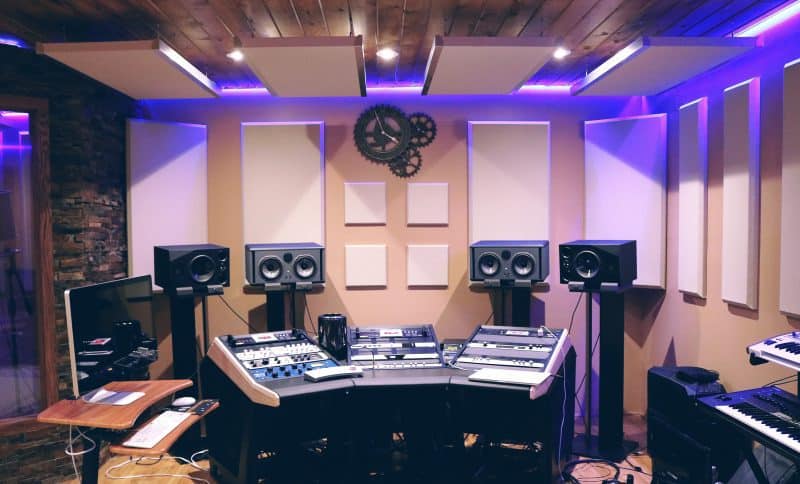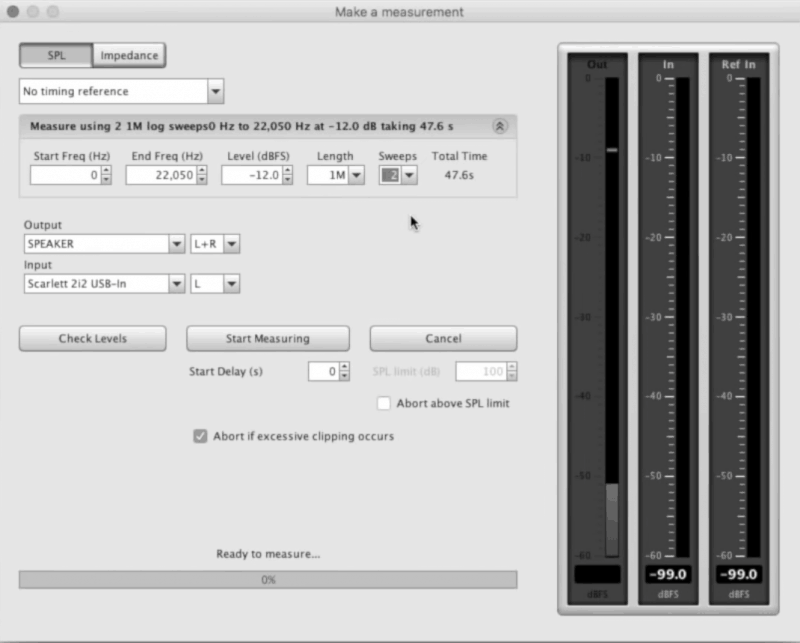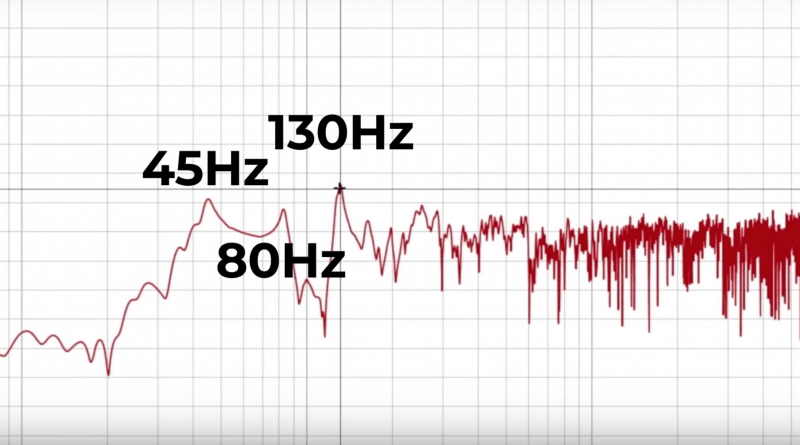Speaker placement is one of the most important parts of setting up your home studio. Get it wrong and you’re in for a mix disaster.
In this article you’ll learn where you should put your speakers to make sure you’re hearing mixes correctly.
Speaker Placement – How to Build a Home Studio
Why is Speaker Placement Important?
Where you put your speakers will have a huge impact on how your mixes sound.

You’ll want to figure out speaker placement before you think about acoustic treatment. In many cases, speaker placement will have an even bigger impact on your mix than how you treat the room.
Poor placement of studio speakers can make parts of the frequency range sound louder or quieter than they actually are. For instance, your low end may have an unnatural boost in volume… leading to a weak bass sound when you play your mix in any other set of speakers.
It can even cause phase issues that will completely cancel out certain frequencies, leaving you with no idea what your mix is actually sounding like.
Basically, poor speaker placement will make your mix sound a lot different in your mixing room than it will when your listeners will actually hear it.
A Quick Disclaimer…
There isn’t a catch-all solution to speaker placement.
There’s dozens of variables that affect the sound of your room. The shape of your room, the size of your room, what the walls are made of, the furniture inside of the room, and so on.
The results you’ll get from this test are a great starting point. But make sure to try out a few different locations to see what works best for you.
What You’ll Need…
You’ll need a few tools to get started. We’ll keep it as inexpensive as possible, though.
You’ll need:
- A tape measure
- A protractor
- Some scratch paper
- An SPL meter (a free phone app will do)
- Room EQ Wizard
- A measurement microphone
It sounds like a lot, but this isn’t as complicated as it seems. In fact, most of the technology on this list is free!
The only investment you’ll need to make is a measurement mic. Those are special microphones that are designed to have extremely flat frequency responses.
You can get a good measurement mic for as cheap as $60. If you really can’t spare the cash, you can use a regular condenser microphone, though your results will be a little skewed.
You may also want to get a couple of floor stands for your speakers. This way you can move them easily and try out different placement options.
Step 1: The Rough Sketch
First, sketch out what your room looks like. Here’s an example sketch of a mixing room:

This room is basically a rectangle with bay windows on the left side.
Try to draw everything to scale. Using graph paper is very helpful when dealing with specific measurements.
This step is pretty simple. Next!
Step 2: Picking Which Side of the Room to Use
Now we need to actually pick a side of the room to put the speakers on.
If you have a rectangular room (and plan to use acoustic treatment), you’ll want to have your speakers pointing down the long hall. This will give us a flatter frequency response, so what we’re hearing will be more accurate.
That means I can put the speakers here:

Or here:

If you’re not going to use any acoustic treatment (though I recommend you do), you may want to put your speakers across the long wall like this:

This will reduce side wall reflections. Side reflections can make your mix sound muddier and even filter out certain frequencies in your room. We’ll talk more about square rooms in the next step.
You’ll also want to think about how each side of your room will impact the sound differently. Keep in mind that high frequencies are extremely directional while low frequencies move in all directions. That means that they’ll even emanate backwards from where your speakers are facing.
I’ve decided to place my speakers right in front of the bay windows. This way the windows can act as a natural bass trap.
Many people warn that windows are bad news for a mixing space. They’re extremely reflective when it comes to high frequencies, so you can end up with a lot more high frequency content than you want. You definitely want to be careful about windows in a mixing space.
But a good thing about them is they allow low frequencies to pass through instead of reflecting them.
Avoiding low frequency buildup is super important in your mixing space, so I’ve opted to let these windows do some of that work for me. Now I won’t have to worry about the low frequencies coming out from behind the speakers.
Plus, I don’t have to worry about the high frequency reflections as well. Thanks to how the windows are angled, they should die off before they even reach me.
The specifics of this example room aside, you want to make sure you’re considering the pros and cons of each side of your room before settling on one.
Step 3: Picking Where to Sit
Before we can decide where the speakers should go, we need to know where exactly where we’ll be sitting while we’re mixing.
Fortunately for us, there’s a very simple way to figure this out! Grab your tape measure and measure the length and width of your room.
Then, find the halfway point of the wall you’ll be putting your speakers in front of. Your desk will be centered on that wall.
Now we need to find how far back from the wall to sit. To do this, we need to multiply the length of the wall next to our mixing station by 38%.
Let’s say our example room is 7 meters by 5 meters. We’ll want to set up halfway along the smaller wall, which is where our speakers are going. So that would be 2.5 meters.

Then, we’ll multiply 7 meters by 38%, which is 2.66 meters. So we want to sit 2.5 meters along the short wall and 2.66 meters back from the wall.

All this being said, 38% into the room is more of a ballpark estimate of where the frequency response will be flattest.
You may find that 42% into the room actually sounds better. I’ve found that there tends to be a wiggle room of 6% forward or backward.
Hopefully the room you’re mixing in isn’t a square. Square rooms tend to have way more acoustical problems.
If you’re stuck with a square room, try treating it like a diamond and put your speakers diagonally in a corner. This will help you cut down on harmful room nodes.
To do this, measure the distance from one corner to another. Then multiply that distance by 38%. That’s where you should sit.

Step 4: Placing Your Speakers
Once you’ve figured out where you should sit, you can figure out where to put your speakers.
There are many mathematical formulas that work best for different types of rooms. For example, a room that’s shaped like a trapezoid has different acoustical needs than a rectangular room.
But there’s a easy method that’ll work in many cases:
Make an equilateral triangle.

Yep, simple as that. You’ll want to point each speaker 30 degrees so that they are aiming at your ears.
That means that you want each speaker to be as far apart from each other as they are from you.
So if I’m sitting 1 meter away from my speakers, my speakers should be 1 meter away from each other.
If your speakers are sitting on your desk, your triangle size is limited to the size of the desk. But if you have speaker stands, you can make your triangle size as large as you’d like.
Generally, a larger triangle creates a more accurate stereo image. However, this isn’t a hard-and-fast rule. Your room may sound different.
Keep in mind that the larger your triangle size is, the closer your speakers are to the wall. You don’t want your speakers up against a wall if you can avoid it. That will cause lots of issues with your bass frequencies.
Try to keep at least half a meter of space between your speakers and the wall.
Step 5: Measuring The Frequency Response
Now that we know the basics, we can test a few different options!
Since every room is different, we still need to run actual tests to find the ideal setup. But all of this theory can help us narrow it down to just a few possibilities.
Sketch out 3 or 4 different speaker setups for your room. For example, you could sketch one version with your speakers on your shorter wall, and another with them on your longer wall.
You could also compare how it sounds when you’re 42% of the way into the room as opposed to 38%.
As you compare these setups, you’re looking for the position that gives you the flattest frequency response possible. Human ears aren’t so great at figuring this out, so this is where technology comes in.
Room EQ Wizard is a free software that will help you measure the frequency response of different places in your room. It plays a sine sweep and uses the input from measurement mic to determine the frequency response.
How to Use Room EQ Wizard
Room EQ Wizard is kind of daunting when you first look at it. But it’s actually quite simple to use.
First, you’ll want to set your room up in the position you’d like to test. Place your speakers where you want them to be and put your measurement microphone where your head would go.
Use a protractor to make sure the speakers are 30 degrees to the left and right of the mic. Then use your tape measure to check that the speakers and mic are all equally far from one another.
Then, boot up EQ Wizard.
First you’ll use Room EQ Wizard to calibrate your soundcard. Check out the video below on how to do that.
After that you can start measuring your different room setups. Make sure your measurement mic is set as the audio input. Then, check the mic’s level by clicking “Next” at the bottom right of the screen.
Turn up the input from your mic until it’s reading a little under -12dB.

Navigate back to the main menu and click on the “Measure” button.

Make sure your length is set to 1M, sweeps is set to 2, and your start and end points are set to 0 and 22,000 respectively.

Hit “Start Measuring.” A sine sweep will play through your speakers and Room EQ Wizard will create a graph of your room’s frequency content. You’ll want to be as quiet as possible during these sweeps to make sure the measurements are accurate.

In this example measurement there are some peaks and dips at 45Hz, 80Hz, and 120Hz. If I were to use this room setup, I’d know I’m going to have problems with these frequencies.
You’ll then repeat the whole process in the next potential listening position.
Once you’ve tested every position, click the “Overlays” button in Room EQ Wizard. Now you can look at all of your graphs at once.

Find the measurement that looks the flattest. Whichever measurement has the fewest peaks and dips is the best position for you to use.
In our example measurements, the green curve is the most consistent. It still has a few peaks, but all in all it’s much smoother than the other options.
NOTE: Here’s How to Spot (And Smash) Nasty Room Resonances:
Step 6: Wrapping Up
Once you’ve found the best listening position, there are still a few things you need to double check before calling it a day.
Step 1: Get your tape measure and make sure the speakers aren’t the same distance from the side wall as they are from the front wall. That can cause some serious issues in your frequency response.
Step 2: Check that the distance between the speakers and your listening position is identical. It’s super important that you form an equilateral triangle with the speakers.
Pro Tip: Mark the ideal listening position on the floor so you won’t forget where it is.
If you have to move your listening position at all to be equilateral with the speakers, take another room measurement to see if your graph changes.
Step 3: Make sure your speakers are at ear level. Your ears should be as high as the middle point between the tweeter and the big cone.
Step 4: Check that the speakers are pointed directly at your ears.
Conclusion
And that’s everything you need to know to find the best place to put your speakers!
Let’s go through the list one more time:
- Step 1: Make a few sketches of your room
- Step 2: Pick a side of the room to put your speakers on
- Step 3: Find the best listening position
- Step 4: Brainstorm a few speaker placement options
- Step 5: Measure the frequency content of those placements
- Step 6: Choose the option that has the flattest frequency response
If you follow these steps, you should be able to find the best spot for your speakers to go!










